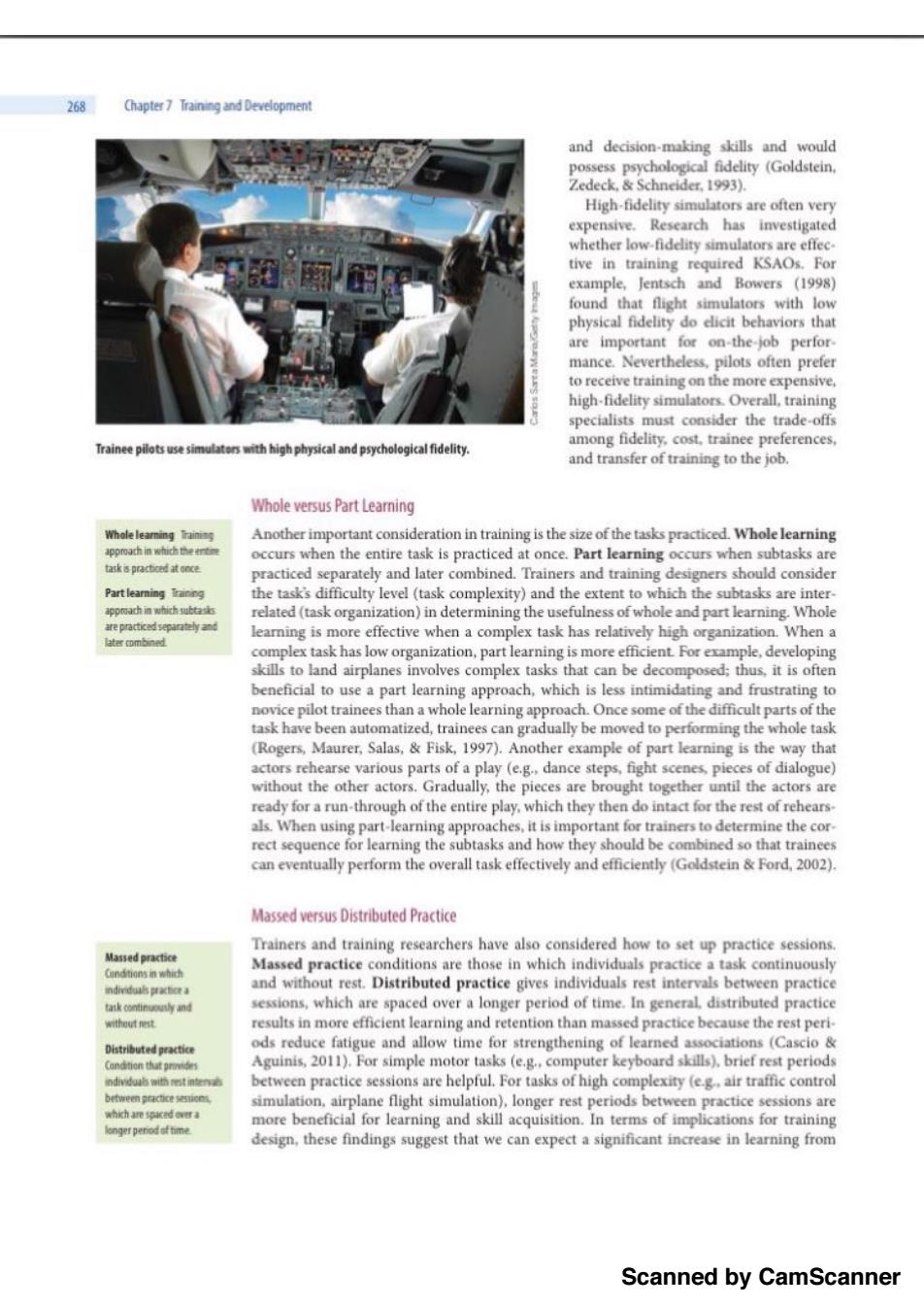正在加载图片...

268 Chapter 7 Training and Development and decision-making skills and would possess psychological fidelity (Goldstein. Zedeck.Schneider.1993). High-fidelity simulators are often very expensive.Research has investigated whether low-fidelity simulators are effec. tive in training required KSAOs.For example,Jentsch and Bowers (1998) found that flight simulators with low physical fidelity do elicit behaviors that are important for on-the-job perfor. mance.Nevertheless,pilots often prefer to receive training on the more expensive, high-fidelity simulators.Overall,training specialists must consider the trade-offs Trainee pilots use simulaters with high physical and psychological fidelity. among fidelity,cost.trainee preferences, and transfer of training to the job. Whole versus Part Learning Whole learing Fraining Another important consideration in training is the size of the tasks practiced.Whole learning p间och in which the ereme occurs when the entire task is practiced at once.Part learning occurs when subtasks are task is practiced at enc生 practiced separately and later combined.Trainers and training designers should consider Part learing Traeng the task's difficulty level (task complexity)and the extent to which the subtasks are inter- app阿ach in whichuba多 related (task organization)in determining the usefulness of whole and part learning.Whole are practiced separatelyand learning is more effective when a complex task has relatively high organization.When a later combined complex task has low organization,part learning is more efficient For example,developing skills to land airplanes involves complex tasks that can be decomposed;thus,it is often beneficial to use a part learning approach,which is less intimidating and frustrating to novice pilot trainees than a whole learning approach.Once some of the difficult parts of the task have been automatized,trainees can gradually be moved to performing the whole task (Rogers,Maurer,Salas,Fisk,1997).Another example of part learning is the way that actors rehearse various parts of a play (e.g.,dance steps,fight scenes,pieces of dialogue) without the other actors.Gradually,the pieces are brought together until the actors are ready for a run-through of the entire play,which they then do intact for the rest of rehears- als.When using part-learning approaches,it is important for trainers to determine the cor. rect sequence for learning the subtasks and how they should be combined so that trainees can eventually perform the overall task effectively and efficiently (Goldstein Ford,2002). Massed versus Distributed Practice Trainers and training researchers have also considered how to set up practice sessions. Massed practice Massed practice conditions are those in which individuals practice a task continuously Candition时nwhh ndidu地ataa and without rest.Distributed practice gives individuals rest intervals between practice taskcontinuously and sessions,which are spaced over a longer period of time.In general.distributed practice heu时mt results in more efficient learning and retention than massed practice because the rest peri- Distributed practice ods reduce fatigue and allow time for strengthening of learned associations (Cascio Condtion tht pdes Aguinis,2011).For simple motor tasks (e.g.,computer keyboard skills).brief rest periods ndividual with mstinten边 between practice sessions are helpful.For tasks of high complexity (eg.air traffic control between practicei simulation.airplane flight simulation),longer rest periods between practice sessions are 肉hhmp时框a longer perodof tme more beneficial for learning and skill acquisition.In terms of implications for training design,these findings suggest that we can expect a significant increase in learning from Scanned by CamScannerScanned by CamScanner